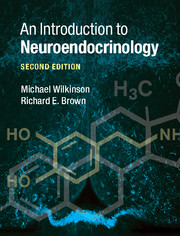Book contents
- Frontmatter
- Dedication
- Contents
- Preface to the second edition
- Acknowledgements
- List of abbreviations
- 1 Classification of chemical messengers
- 2 The endocrine glands and their hormones
- 3 The pituitary gland and its hormones
- 4 The hypothalamic hormones
- 5 Neurotransmitters
- 6 Neurotransmitter and neuropeptide control of hypothalamic, pituitary and other hormones
- 7 Regulation of hormone synthesis, storage, release, transport and deactivation
- 8 Regulation of hormone levels in the bloodstream
- 9 Steroid and thyroid hormone receptors
- 10 Receptors for peptide hormones, neuropeptides and neurotransmitters
- 11 Neuropeptides I: classification, synthesis and co-localization with classical neurotransmitters
- 12 Neuropeptides II: function
- 13 Cytokines and the interaction between the neuroendocrine and immune systems
- 14 Methods for the study of behavioral neuroendocrinology
- 15 An overview of behavioral neuroendocrinology: present, past and future
- Index
- References
8 - Regulation of hormone levels in the bloodstream
Published online by Cambridge University Press: 05 June 2015
- Frontmatter
- Dedication
- Contents
- Preface to the second edition
- Acknowledgements
- List of abbreviations
- 1 Classification of chemical messengers
- 2 The endocrine glands and their hormones
- 3 The pituitary gland and its hormones
- 4 The hypothalamic hormones
- 5 Neurotransmitters
- 6 Neurotransmitter and neuropeptide control of hypothalamic, pituitary and other hormones
- 7 Regulation of hormone synthesis, storage, release, transport and deactivation
- 8 Regulation of hormone levels in the bloodstream
- 9 Steroid and thyroid hormone receptors
- 10 Receptors for peptide hormones, neuropeptides and neurotransmitters
- 11 Neuropeptides I: classification, synthesis and co-localization with classical neurotransmitters
- 12 Neuropeptides II: function
- 13 Cytokines and the interaction between the neuroendocrine and immune systems
- 14 Methods for the study of behavioral neuroendocrinology
- 15 An overview of behavioral neuroendocrinology: present, past and future
- Index
- References
Summary
As illustrated in Figures 6.5 and 6.11, pituitary (LH, FSH and ACTH) and steroid (cortisol) hormone levels in the bloodstream fluctuate dramatically over short periods of time (minutes to hours). In addition, hormones such as GH, ACTH and melatonin show marked circadian variations in their secretion patterns (Figure 6.5). These patterns are physiologically important; for example, we saw in the case of LH secretion, a continuous release, rather than a pulsatile secretion, will not stimulate the ovaries or testes correctly (Figure 7.4). In other words, fertility is dependent on an appropriate pulsatile LH signal reaching the gonads. This principle might be generally applicable to all pituitary hormone secretions. The measurement, or assay, of hormone levels is therefore an important clinical goal, as well as a crucial aid in understanding how hormone levels in blood are regulated and how the neuroendocrine system functions in health and disease. This chapter thus begins with an examination of the methods for measuring hormone levels in the circulation.
Analysis of hormone levels
The level of a circulating hormone can be measured directly in blood samples or estimated by measuring hormone levels in the saliva, urine or feces, measuring urinary metabolites, or by using bioassays. The determination of glucocorticoids levels in hair, for example, is a way to detect long-term exposure to stress.
8.1.1 Direct measurement of circulating hormones
In the past 20 years, there have been striking changes in the analytical techniques used to estimate hormone levels. Until recently, the benchmark in determination of hormone levels was the radioimmunoassay. However, this method, employing antibodies specific to each hormone, and radioactively labeled hormones, is slow, labor-intensive and raised safety problems in the use and disposal of radioactive materials. It is now routine to analyze hormone levels using rapid and automated chemiluminescent or immunometric assays that produce data in a matter of hours, rather than days.
A widely used assay is the Enzyme-linked Immunosorbent Assay (ELISA).
- Type
- Chapter
- Information
- An Introduction to Neuroendocrinology , pp. 170 - 191Publisher: Cambridge University PressPrint publication year: 2015



